Hesperian Health Guides
Wheelchair with Lying Board
HealthWiki > Disabled Village Children > Chapter 66: Designs for 6 Basic Wheelchairs > Wheel Chair with Lying Board
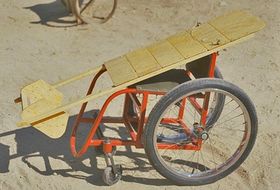
This is useful for an active child who must lie face down to heal pressure sores or to stretch hip and knee contractures.
The board is sloped so that the child can play, look ahead, and move about more easily. If necessary, you can make the lying board adjustable so that the child can rest lying flat. This helps to improve circulation and to prevent swelling of the feet.
After the pressure sores heal, the lying board can be removed and the frame is easily adapted to form a lightweight wheelchair.
The design we show uses a simple, non-folding steel tube wheelchair frame with a wooden lying board mounted on top. However, many other designs are possible. (See, for example, this photo of a lying and standing wood wheelchair.)


THE LYING BOARD
| SIDE VIEW | |
| Attach thin wood or plywood boards with small screws so that they can be easily adjusted to leave open spaces under bony parts or sores. |
 strong wood pole (or 1” square tubing)
rack to hold urine pot (if needed)
adjustable footrest |


FOOTREST
| Use thin wood or plywood. (Pad sides and bottom well to prevent sores. Examine feet daily.) |  |
REMOVABLE HANDLE
 cloth or woven plastic seat and back
book basket |
 pieces that fit into side tubes |
FRONT CASTER WHEEL
 ¾" square tubing
½" round tubing
⅝" bolt
shopping cart wheel with holes drilled for lighter weight |
You should now have enough information to make a wheelchair with a lying board without step-by-step instructions. Adapt it, and make it the size to fit the child that needs it. |
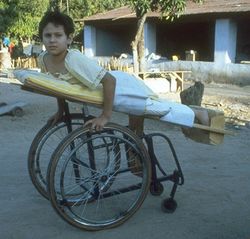 |
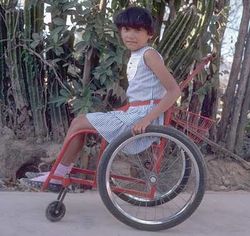 |
| Wheelchair with lying board. A wide strap holds the child in place (but take care it does not press on sores). | Wheelchair without lying board. |
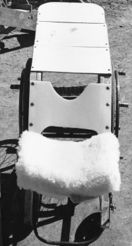 |
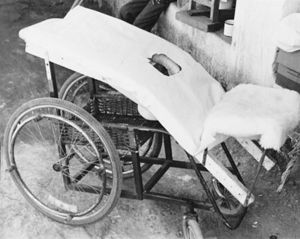 |
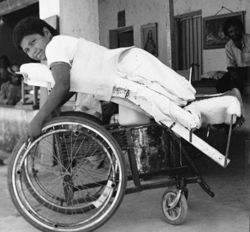 |
| A variation of the wheelchair with lying board adapted for a child with paraplegia with both contractures and pressure sores of his hips and knees. Urine is collected in a plastic container. The wheelchair seat has been converted into a basket. | ||


